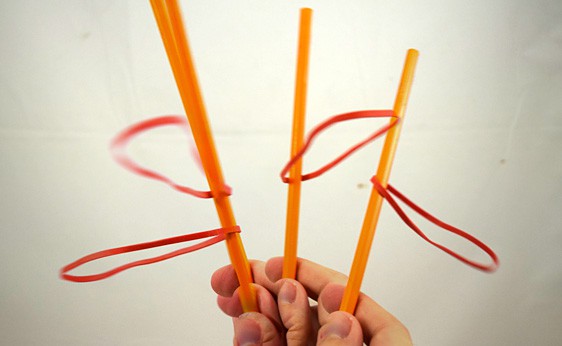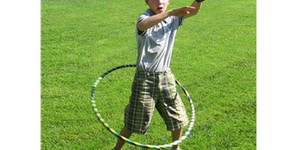Hula Hooping with a Rubber Band
Summary

Introduction
Are you any good at hula hooping? If not, there is good news: you can do this fun project without any hula hooping experience! You will examine some of the fascinating physics behind hula hooping using just a pencil and a rubber band.
Materials
- Pencil
- Rubber band
Instructions
- Hold the pencil by the eraser end and point the tip up.
- Loop the rubber band over the pencil so it falls down to your fingers.
- Slowly start to twirl the pencil.
- Keep twirling the pencil faster and faster.How fast do you have to twirl it before the rubber band starts moving up?
- Try to twirl the pencil so fast that you get the rubber band to fly off the tip.
- Try changing the angle of the pencil as you twirl it. (Hint: you probably do not keep the pencil perfectly vertical as you twirl it.) Pinch the eraser end with your finger and thumb, and spin the tip around in a circle, tracing out a three-dimensional cone.What happens if you make this "cone" wider? Does it make it easier or harder for the rubber band to move upward?
- Try rotating your wrist as you twirl the pencil, so the pencil becomes horizontal and eventually upside down (so the tip points down).Can you keep the rubber band on the pencil even when it is upside down?
What Happened?
In this activity, the pencil acts like a person's body and the rubber band acts like a hula hoop. Just like with a real hula hoop, you should have found that if you did not spin the pencil fast enough, the rubber band would fall down. As you spin the pencil faster and/or make the cone you trace with the pencil wider, the rubber band should start to move up the pencil, and eventually fly off the tip! For a more detailed explanation of the physics behind this project, see the Digging Deeper section.
Digging Deeper
Hula hooping is all about forces! You might not think about physics much when you play with a hula hoop, but there are many different forces at work that help keep a hula hoop spinning and prevent it from falling to the ground. A force is a push or a pull that acts on an object. Forces can make things move, but just because something isn't moving does not mean that it has no forces acting on it. For example, if you are sitting in a chair as you read this, the chair is exerting an upward force on you that prevents you from falling to the ground. On the other hand, just because something is moving does not necessarily mean it has force acting on it. An object moving at a constant velocity will keep moving in a straight line forever if there is no force to slow it down (Newton's first law of motion).
So what forces act on a hula hoop?
- Weight, or the force of gravity pulling the hula hoop down.
- Friction, the force that opposes motion between two surfaces that are sliding against each other (in this case, the friction between the hula hoop and your clothes).
- The normal force. In physics, "normal" means "perpendicular (at a right angle) to," not "regular" like it does in everyday speech. The normal force is the force that acts perpendicular to two surfaces that are touching each other. For example, a book sitting on a table has a normal force from the table pushing it up, which prevents it from falling. If you push your hand against a wall, the wall exerts a horizontal normal force against your hand (Newton's third law of motion).
- The centripetal force, which is the force that keeps a rotating object moving in a circle, instead of flying off in a straight line. For example, imagine twirling a rock on a string. The tension in the string pulls on the rock and makes it move in a circle. If you suddenly cut the string, there is no more centripetal force acting on the rock, and it will fly away instead of continuing to move in a circle. In a hula hoop, the centripetal force results from your body pushing on the hoop (a combination of friction and normal force).
The combined effect of these forces determines the hula hoop's motion (Newton's second law of motion).
To understand the physics behind twirling the rubber band, think about the example of centripetal force and twirling a rock on a string. The rock "wants" to keep moving in a straight line, but the centripetal force from the string makes it move in a circle. The rubber band behaves in a similar manner. It "wants" to fly off in a straight line, but the centripetal force from the pencil* makes it move in a circle. If you spin the pencil fast enough, the centripetal force is no longer strong enough to hold the rubber band in place—so it starts sliding outward (and upward). This makes it very difficult, if not impossible, to keep the rubber band on the pencil when you hold it upside down.
*Since the pencil is at an angle, this force is made of the components of the frictional and normal forces that act in the horizontal direction. See this page for more information.
Ask an Expert
For Further Exploration
- Try using different size rubber bands. Which is easier to twirl: a big rubber band or a small one?








